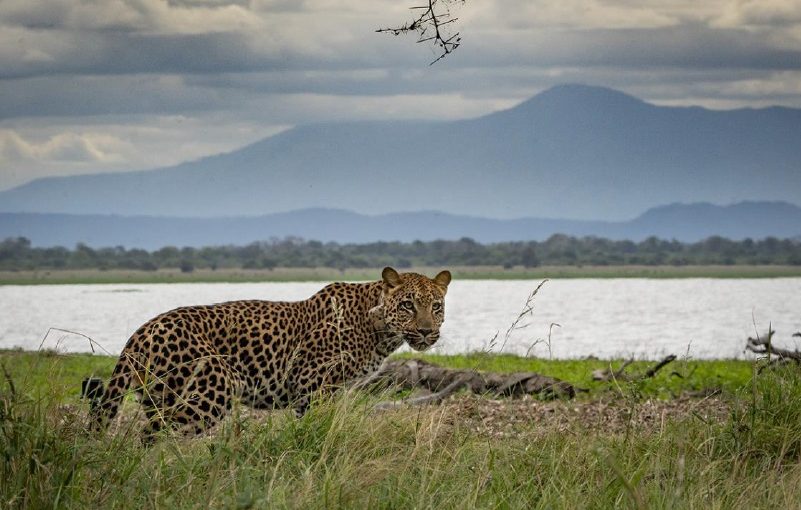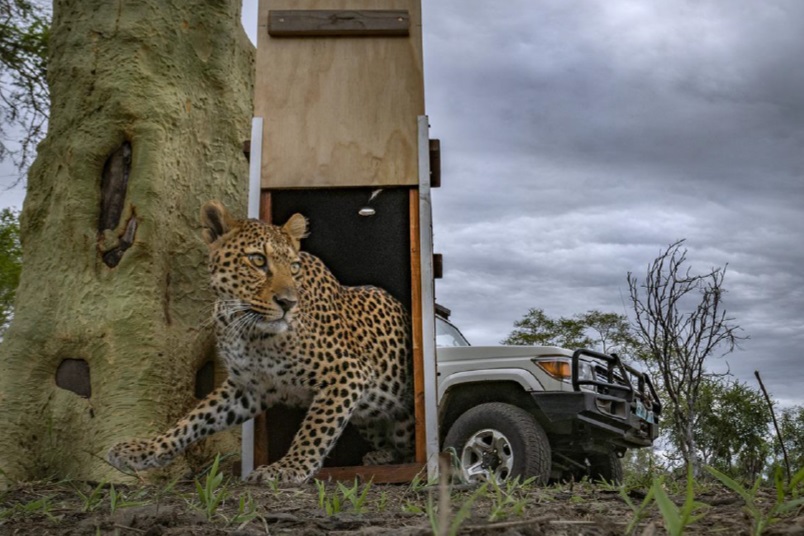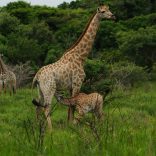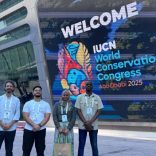Four giraffe species officially recognised in major conservation reclassification – IUCN report
Leopards prowl again in Gorongosa.

The leopards will feel totally at home in Gorongosa National Park (Photo: Piotr Naskrecki)
With its iconic spots, powerful body, and captivating eyes, the leopard is widely revered as one of the world’s most beautiful animals, earning it a coveted place on ‘Africa’s Big Five’ list, along with lions, elephants, rhino, and Cape buffalo.
On Wednesday, April 21st, three adult leopards—two males and one female—were translocated by air from South Africa to Gorongosa National Park, Mozambique and released into their new wild home: 400,000 hectares of fever tree and palm forests, rivers, lagoons, and lush floodplain.

“This is another special day in Gorongosa—an important moment in the restoration of the Park,” said Pedro Muagura, Park Warden. “After many years without them, we’re delighted to have these majestic big cats prowling in Gorongosa again,” he added. Wednesday’s release builds on the successful translocation of the 1st adult female leopard from South Africa in November, 2020.
Gorongosa National Park is an ideal home for leopards: dense thickets, tall trees, and lots of impala—their preferred hunting target. 50 years ago, the park was a perfect stalking ground, home to a healthy population of leopards. But decades of war and illegal hunting took a heavy toll on all the Park’s carnivores—and their prey base.
Today, thanks to over a decade of protection by Gorongosa’s dedicated Ranger team, there are enough prey animals to sustain large predators again. Following the successful recovery of lions—from just a few to over 150—and the recent release of several Painted Wolf (a.k.a. African Wild Dog) packs, leopards are the latest members of the ‘Carnivore Guild’ to return to their rightful place at the top of the Gorongosa food chain.
All predators perform vital ecological functions but these leopards will play a particularly important role in Gorongosa. Over the past twenty years, the population of baboons has exploded due to the absence of leopards, their main predator. Gorongosa now has likely the largest concentration of baboons in Africa—with over 218 troops documented and an estimated 10,000 individuals.
Baboon overpopulation creates a ‘cascade-effect’ throughout the ecosystem. For example, more baboons could negatively impact the populations of many bird species because baboons raid birds’ nests and eat the eggs. Fewer birds could mean more insects, and so on. The return of leopards should help control the baboon population and eventually bring the ecosystem back into balance.
The arrival of these three new leopards brings the total known population to five. In 2018, a lone male leopard (likely an immigrant from a nearby area) was spotted by tourists, the first leopard to be seen in the Park in over 15 years. The female leopard flown to Gorongosa last November (known as ‘Sena’, or ‘Earth’s grace’) is also thriving.
Now, with the addition of two more males and one more female, the hope is that these leopards will mate and give Gorongosa its first leopard cubs in decades. (Females give birth to two to five cubs and mothers stay with their cubs for about 2 years.) One of the males was released next to the site of the new Muzimu Camp, scheduled to open in September of this year. With any luck, guests at Muzimu (meaning ‘Spirit’) will soon be able to experience the thrill of meeting Gorongosa’s newest safari superstars.
Bringing leopards back to Gorongosa is the culmination of years of planning and effort by the Park’s Conservation team. “Everyone pulled together to make it happen and it’s a truly collaborative effort that involves multiple partners working across international borders succeed,” said Dr. Rui Branco, Director of Conservation. “It’s such a privilege for the entire team to be part of such historic conservation work,” he added.
The leopard translocation has taken several years to organize and was made possible by an exceptionally committed team including the Gorongosa Restoration Project, Mozambique’s Administração Nacional das Áreas de Conservação (ANAC), Mpumalanga Tourism and Parks Agency (MTPA), Wildlifevets.com, Natura, United States Agency for International Development (USAID), the Oak Foundation, and the Pilatus Center SA.

Leopards are listed as “Vulnerable” on the IUCN Red List of Threatened Species and have retreated from 65% of their historic range in Africa, according to Panthera, a leading big cat conservation organisation. Despite the threats they face in other places, these leopards have a warm and welcoming new home in Gorongosa—and their future looks very bright.
About the Gorongosa Project
Gorongosa National Park (GNP) in Mozambique is perhaps Africa’s greatest wildlife restoration story. In 2008, a 20-year Public-Private Partnership was established for the joint management of GNP between the Government of Mozambique and the Carr Foundation (Gorongosa Restoration Project), a US nonprofit organisation. In 2018, the Government of Mozambique signed an extension of the joint management agreement for another 25 years. By adopting a 21st Century conservation model of balancing the needs of wildlife and people, Gorongosa is protecting and saving this beautiful wilderness, returning it to its rightful place as one of Africa’s greatest national parks.
GNP has been described as one of the most diverse parks on Earth, covering a vast expanse of 400,000 hectares. In recent years, the Gorongosa Project, with the support of Mozambique’s National Administration of Conservation Areas (ANAC), has ensured the protection of a recovering population of lions in this system, successfully reduced key threats, and has been recognised as one of National Geographic’s “Last Wild Places” and by TIME Magazine as one of the “World’s Greatest Places – 2019”.












Leave a Reply
Be the First to Comment!
You must be logged in to post a comment.
You must be logged in to post a comment.